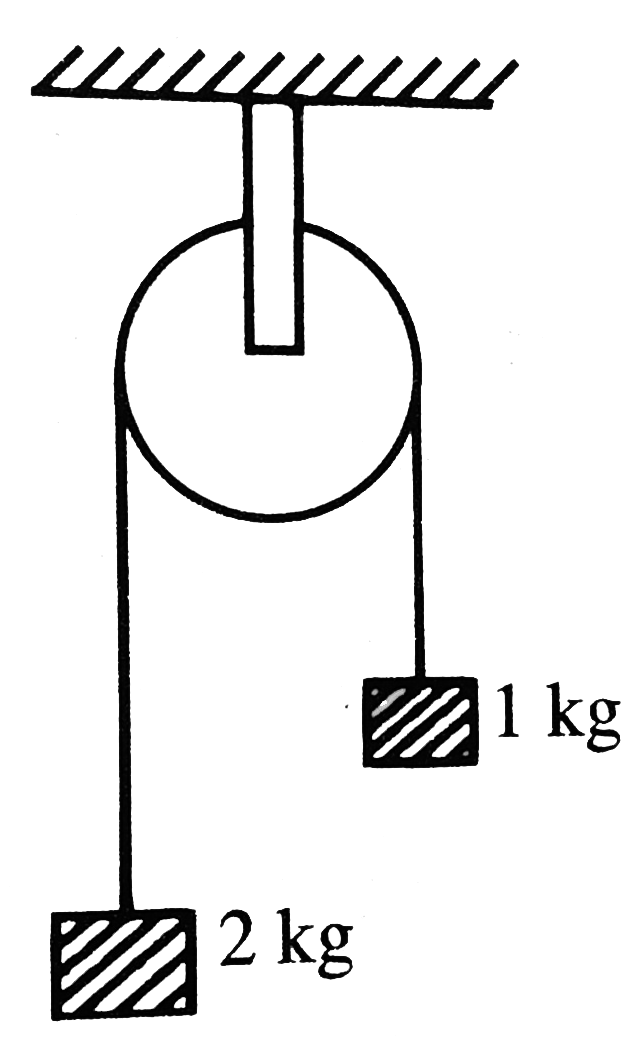A stress of 106N/m2 is required for breaking a material. If the density of the material is 3×103Kg/m3, then what should be the minimum length of the wire made of the same material so that it breaks by its own weight (g=10m/s2)
10 m
33.3 m
5 m
66.6 m
The correct Answer is:B
To find the minimum length of the wire made of the same material that will break under its own weight, we can follow these steps:
1. Understand the Concept of Stress:
Stress (σ) is defined as the force (F) applied per unit area (A). The formula for stress is given by:
σ=FA
2. Identify the Force due to Weight:
The force acting on the wire due to its own weight can be expressed as:
F=mg
where m is the mass of the wire and g is the acceleration due to gravity.
3. Express Mass in Terms of Density and Volume:
The mass m of the wire can be expressed in terms of its density (ρ) and volume (V):
m=ρV
The volume of the wire can be expressed as:
V=A⋅L
where A is the cross-sectional area and L is the length of the wire. Thus, we have:
m=ρAL
4. Substitute Mass into the Force Equation:
Substituting the expression for mass into the force equation gives:
F=ρALg
5. Substitute Force into the Stress Equation:
Now we can substitute F into the stress equation:
σ=FA=ρALgA=ρLg
6. Rearranging for Length:
To find the length L that will cause the wire to break, we can rearrange the equation:
L=σρg
7. Substituting Given Values:
We know from the problem:
- Breaking stress σ=106N/m2
- Density ρ=3×103kg/m3
- Acceleration due to gravity g=10m/s2
Substituting these values into the equation for L:
L=1063×103×10
8. Calculating the Length:
Performing the calculation:
L=1063×104=1063×104=1023≈33.33m
Final Answer:
The minimum length of the wire that will break under its own weight is approximately 33.33 meters.
Stress (σ) is defined as the force (F) applied per unit area (A). The formula for stress is given by:
σ=FA
The force acting on the wire due to its own weight can be expressed as:
F=mg
where m is the mass of the wire and g is the acceleration due to gravity.
The mass m of the wire can be expressed in terms of its density (ρ) and volume (V):
m=ρV
The volume of the wire can be expressed as:
V=A⋅L
where A is the cross-sectional area and L is the length of the wire. Thus, we have:
m=ρAL
Substituting the expression for mass into the force equation gives:
F=ρALg
Now we can substitute F into the stress equation:
σ=FA=ρALgA=ρLg
To find the length L that will cause the wire to break, we can rearrange the equation:
L=σρg
We know from the problem:
- Breaking stress σ=106N/m2
- Density ρ=3×103kg/m3
- Acceleration due to gravity g=10m/s2
L=1063×103×10
Performing the calculation:
L=1063×104=1063×104=1023≈33.33m
The minimum length of the wire that will break under its own weight is approximately 33.33 meters.
Topper's Solved these Questions
- ELASTICITYBOOK - DC PANDEY ENGLISHCHAPTER - ELASTICITYEXERCISE - Match the columns
4 Videos
- ELASTICITYBOOK - DC PANDEY ENGLISHCHAPTER - ELASTICITYEXERCISE - Medical entrances s gallery
21 Videos
- ELASTICITYBOOK - DC PANDEY ENGLISHCHAPTER - ELASTICITYEXERCISE - Check point 12.3
15 Videos
- CURRENT ELECTRICITYBOOK - DC PANDEY ENGLISHCHAPTER - CURRENT ELECTRICITYEXERCISE - All Questions
469 Videos
- ELECTROSTATICSBOOK - DC PANDEY ENGLISHCHAPTER - ELECTROSTATICSEXERCISE - Integer
17 Videos
Similar Questions
A substance breaks down under a stress of 105 Pa. If the density of the substance is 2×103kgm3, find the minimum length of the wire made of this substance which will break under its own weight (g=10ms2)
View SolutionA material beaks up under a stress of 20×105N/m2. If the density of the material is 2.5×103kg/m3, calculate the length of a wire made of this material, which on hanging may break under its own weight. (g=9.8m/s2)
View Solution
Knowledge Check
Two blocks of masses 1kg and 2kg are connected by a metal wire going over a smooth pulley as shown in figure.
The breaking stress of the metal is (40/3π)×106N/m2. If g=10ms−2, then what should be the minimum radius of the wire used if it is not to break?
 A0.5 mmB1 mmC1.5 mmD2 mm
A0.5 mmB1 mmC1.5 mmD2 mm
A substance breaks down under a stress of 105Pa. If the density of the wire is 2×103kg/m3, find the minimum length of the wire which will break under its own weight (g=10ms−12).
View SolutionBreaking stress for a material is 2×108N/m2. What maximum length of the wire of this material can be taken t the wire does not break by own weight? Density of material = 5×103kg/m3
View SolutionThe breaking stress for a metal is 9×1010Nm−2 The density of the metal is 9000kgm−3 . If g=10Nkg−1 , the maximum length of the wire made of this metal which may be suspended without breaking is 10k m . Find the value of k.
View SolutionThe speed of longitudinal mechanical wave in a material is 4300 m/s. young's modulus of the material is 15×109N/m2. What is the density of the material?
View SolutionThe density of iron is 7.8×103kg m−3 What is its relative density?
View SolutionThe breaking stress of a material is 108Nm−2. Find the greatest length of a wire that could hang vertically without breaking? Density of material =3000kgm−3.
View SolutionTwo blocks of masses 1kg and 2kg are connected by a metal wire going over a smooth pulley as shown in figure.
The breaking stress of the metal is (40/3π)×106N/m2. If g=10ms−2, then what should be the minimum radius of the wire used if it is not to break?

View Solution
